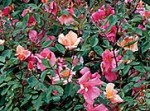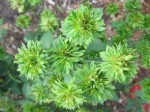 When China roses were introduced into the West at the end of the 1700s, rose growing changed dramatically. Rosa chinensis brought a new gene pool to the West that introduced several new characteristics that European rose growers found highly desirable and they began breeding new rose varieties to include them. Even today, we admire some of the qualities brought by the China roses and continue breeding programs that capitalize on them.
When China roses were introduced into the West at the end of the 1700s, rose growing changed dramatically. Rosa chinensis brought a new gene pool to the West that introduced several new characteristics that European rose growers found highly desirable and they began breeding new rose varieties to include them. Even today, we admire some of the qualities brought by the China roses and continue breeding programs that capitalize on them.
The most sought after trait brought by the China roses was repeat blooming. The ‘Autumn Damask’ rose of the West had repeat bloom but other old roses bloomed only once. With the introduction of the China roses, the trend toward repeat blooming plants began and continues even today.

Another unique quality of China roses is their tendency to darken as they age. They can start out yellow and pass through several color changes including orange and pink, ending in dark red. This change is a remarkable sight and keeps the whole bush alive with color the entire time it is in bloom. Before the introduction of China roses, the roses faded as they aged, and did not include the color yellow or dark red.
Although the fragrance of China roses is light, the Chinas brought new scents that produced pleasing blends when combined with the fragrance of western roses. The new scents are often described as fruity or peppery and added a whole new dimension to rose fragrances.
The buds and flowers of Chinas were quite different in form from the large round buds and flat flowers of western roses that were grown at the time. China roses brought the high centered form that is prized by hybrid tea growers. Along with this characteristic came long slender buds that unfurl as they open.
Of course, China roses had some characteristics that we do not find so desirable. One of these is weak flower bearing stems making Chinas poor vase flowers. Other negatives are a lack of hardiness and a twiggy growth habit. In spite of their faults Chinas can be very good garden plants especially when planted in small groups. They are undaunted by the heat of summer and bloom abundantly when other roses take a rest as they wait for cooler temperatures.
Flower Size: Small to medium
Petal Number: Single or double (5-40 petals) depending on variety
Flower Form: High center
Flower Substance: Medium
Flowering: Repeat
Fragrance. Slight; fruity
Stem: Weak and does not support flower well
Size of Bush: Generally small (3’) but some can be large
Disease Resistance: Resistant to black spot but susceptible to powder mildew.
Hardiness: Zone 7 to 9
Outstanding Examples:

-
‘Old Blush’ (semi-double, lilac pink, to 6’)
‘Mutablis’ (large bush with flowers that open yellow and darken to orange, pink, and dark red)
‘Archduke Charles’ (Fragrant, pink flowers fading to dark red on low bush with sparse foliage)
‘Green Rose’ (green flowers make good fillers in arrangements).
